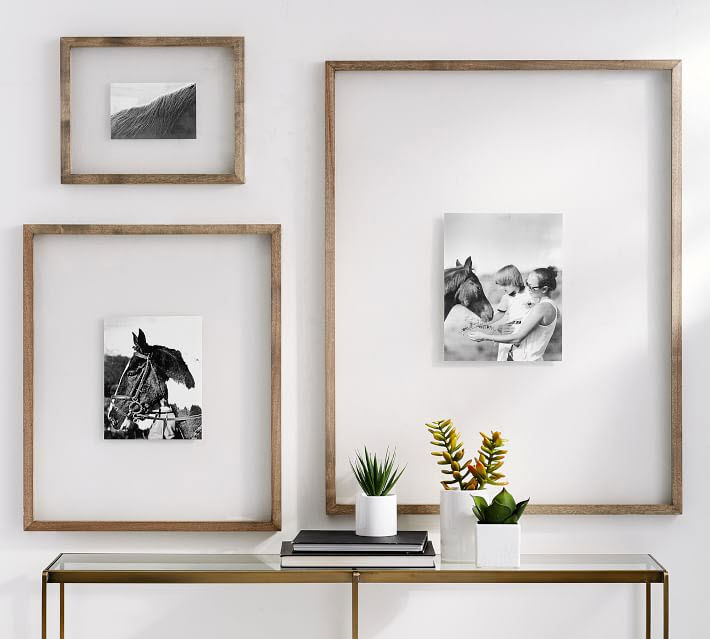How to Choose the Perfect Floating Frame for Your Canvas Art: A Complete Buyer's Guide
- Kevin Martin

- Aug 13
- 7 min read
Updated: Aug 13

Choosing the right floating frame for your canvas art can transform a beautiful piece into a stunning focal point that commands attention and admiration. Whether you're framing a treasured family photo printed on canvas, showcasing an original painting, or displaying artwork you've invested in, the frame you choose makes all the difference in how your piece is perceived and preserved.
With so many options available – from mass-produced frames to handcrafted custom pieces – making the right choice can feel overwhelming. This comprehensive guide will walk you through everything you need to know to select a floating frame that not only protects your artwork but elevates it to gallery-quality presentation.
Understanding Canvas Floating Frames: The Basics
A floating frame creates the illusion that your canvas artwork is suspended within the frame, with a shadow gap visible around all four edges. Unlike traditional frames that overlap the edges of your artwork, floating frames allow you to see the entire canvas surface, including any wrapped edges or artistic details that extend to the borders.
This framing style has become increasingly popular because it offers a clean, contemporary look that works beautifully in both modern and traditional spaces. The floating effect adds depth and dimension to your artwork while providing the protection and finished appearance that unframed canvas sometimes lacks.
Canvas Depth: Your Starting Point
Before you can choose the perfect floating frame, you need to know the depth of your canvas. Most canvas artworks fall into these standard depths:
3/4 inch (19mm): Common for lighter canvas prints and some original paintings
1 inch (25mm): Standard depth for many canvas prints and medium-weight paintings
1.5 inches (38mm): The most popular depth for gallery-wrapped canvas and substantial artwork
2 inches (50mm): Used for premium gallery wraps and heavy original paintings
To measure your canvas depth, simply use a ruler to measure from the front surface to the back of the stretcher bars. This measurement is crucial because your floating frame must accommodate the full depth of your canvas while still creating that signature floating effect.
Size Considerations: Getting the Proportions Right
The size of your floating frame directly impacts the visual effect and the success of the overall presentation. Here's what you need to consider:
The Float Gap
This is the space between your canvas edges and the inside of the frame. A gap that's too narrow loses the floating effect, while a gap that's too wide can make the artwork feel lost. The ideal float gap is typically 1/4 to 3/8 inch on all sides, though this can vary based on the size and style of your artwork.
Frame Width
The width of the frame material itself affects the overall presence of the piece. Narrower frames (1-2 inches) create a more subtle, contemporary look that lets the artwork dominate. Wider frames (3-4 inches) make a bolder statement and work well for larger pieces or when you want the frame to contribute more to the overall design.
Room Scale
Consider where the framed piece will hang. A small floating frame might get lost on a large wall, while an oversized frame could overwhelm a intimate space. The frame should feel proportional to both the artwork and its intended location.
Wood Selection: Character and Color Coordination
The wood you choose for your floating frame significantly impacts the final look and feel of your presentation. Each type of wood brings its own character, and the right choice depends on your artwork, your space, and your personal style.
Reclaimed Barn Wood
Offers rich patina and authentic character that complements rustic, farmhouse, or industrial décor. The weathered texture and natural variations add warmth and history to your display. This choice works particularly well with landscapes, vintage-style photography, or artwork with earth tones.
Walnut
Provides sophisticated dark chocolate tones with beautiful grain patterns. Walnut floating frames create elegant contrast with lighter artwork and complement contemporary or traditional spaces equally well. The rich color enhances the perceived value of your artwork.
Oak
Classic and versatile, oak offers durability and timeless appeal. Its prominent grain pattern adds texture and interest while maintaining a neutral palette that works with virtually any artwork or décor style.
Pine
Lighter in color with subtle grain, pine creates a fresh, clean look that's perfect for modern spaces or artwork with cool color palettes. It's also an excellent choice when you want the frame to provide structure without competing with bold or colorful artwork.
Custom Stained Options
Many handcrafted frame makers offer custom staining to match specific color requirements or coordinate with existing décor elements.
Quality Indicators: What Separates Good from Great
When evaluating floating frames, several quality indicators will help you identify pieces that will serve your artwork well for decades to come:
Joinery Methods
Look for frames constructed with traditional joinery techniques like mortise and tenon or dovetail joints rather than simple butt joints held together with screws or staples. Proper joinery ensures the frame will remain square and strong over time.
Material Thickness
Quality floating frames use substantial wood stock that won't warp or bow under the weight of your canvas. Thin, lightweight materials may seem appealing for their lower cost, but they often result in frames that don't maintain their shape or provide adequate support.
Mounting System
The method used to secure your canvas within the frame affects both the appearance and the security of your artwork. Quality frames use offset clips or mounting brackets that hold the canvas securely while maintaining the proper float gap. Avoid systems that require you to modify your canvas or use adhesives.
Finish Quality
A well-applied finish not only protects the wood but enhances its natural beauty. Look for smooth, even finishes without drips, brush marks, or rough spots. The finish should complement the wood's natural character rather than obscuring it.
Hardware
Quality hanging hardware appropriate for the weight of your framed piece is essential. Professional-grade wire, D-rings, or sawtooth hangers ensure your artwork will hang securely and level.
Matching Frame Style to Artwork
Different types of artwork benefit from different floating frame approaches:
Photography Printed on Canvas
Often works best with cleaner, more contemporary frame styles that don't compete with the photographic image. Consider darker woods or stained finishes that provide contrast without overwhelming the image.
Original Paintings
The frame choice should complement the painting's style and era. Abstract contemporary work might pair beautifully with sleek, minimal frames, while traditional landscapes could benefit from frames with more character and warmth.
Mixed Media or Textured Artwork
Pieces with significant texture or three-dimensional elements need frames with adequate depth clearance. The frame style should acknowledge and complement the artwork's complexity without competing with it.
Black and White Artwork
Creates opportunities for dramatic contrast with both light and dark frame materials. Consider how the frame color affects the perceived contrast and mood of the piece.
The Handcrafted Advantage
While mass-produced floating frames are readily available, handcrafted frames offer several advantages that make them worth considering for your important artwork:
Custom Sizing
Handcrafted frames can be made to accommodate any canvas size, including non-standard dimensions that might be difficult to frame with off-the-shelf options.
Material Selection
Working with a craftsperson allows you to select specific wood pieces that complement your artwork perfectly. You might choose a particular grain pattern, color variation, or level of character that enhances your specific piece.
Quality Construction
Experienced frame makers use techniques and materials that result in frames built to last generations. The difference in durability and appearance becomes apparent over time.
Personal Consultation
A skilled craftsperson can offer guidance on proportion, color, and style decisions based on experience with similar projects. This expertise can be invaluable in achieving the best possible result.
Making Your Decision: A Step-by-Step Approach
Measure your canvas depth and overall dimensions accurately
Consider your space and décor style to narrow wood and finish options
Evaluate your artwork's colors, style, and mood to guide frame selection
Determine your quality requirements and budget parameters
Choose between ready-made and custom options based on your specific needs
If going custom, consult with your frame maker about material samples and options
Common Mistakes to Avoid
Choosing Frame Size Based on Canvas Size Alone
Remember to account for the float gap – your frame will be larger than your canvas dimensions.
Ignoring Canvas Depth
A frame that's too shallow won't accommodate your canvas properly, while one that's too deep may not provide adequate support.
Prioritizing Price Over Quality
A poorly made frame can detract from even the most beautiful artwork, while a quality frame enhances and protects your investment.
Overlooking Mounting Hardware
Ensure your chosen frame includes appropriate hanging hardware for the total weight of the framed piece.
Rushing the Decision
Take time to consider samples and mock-ups when possible. The frame choice significantly impacts your artwork's presentation and your long-term satisfaction.
The Investment Perspective
A quality floating frame is an investment in your artwork that pays dividends in both protection and presentation. While the initial cost might be higher than basic alternatives, consider the long-term value:
Protection
A well-made frame protects your canvas edges from damage and warping.
Presentation
Professional framing increases the perceived value and impact of your artwork
Durability
Quality construction means your frame will serve your artwork for decades
Flexibility
A classic, well-made frame can be repurposed for future artwork if needed
Bringing It All Together
Choosing the perfect floating frame for your canvas art is about balancing multiple factors: the technical requirements of your specific canvas, the aesthetic goals for your space, and the quality standards that match your investment in the artwork itself.

At Leesburg Reclaimed Wood, we understand that every piece of artwork is unique, and every space has its own character. That's why we work closely with each customer to create floating frames that don't just hold artwork – they honor it. Using traditional craftsmanship techniques and carefully selected reclaimed materials, we create frames that enhance your artwork while adding their own story of American craftsmanship and sustainability.
Whether you're framing a family treasure, showcasing an art investment, or creating a gallery wall of your favorite pieces, the right floating frame transforms good artwork into great presentation. Take the time to choose thoughtfully, and you'll create a display that brings you joy for years to come.
Ready to find the perfect floating frame for your canvas art? We'd love to help you create a handcrafted treasure that showcases your artwork beautifully. Contact us to discuss your project and discover how the right frame can transform your space.












Comments